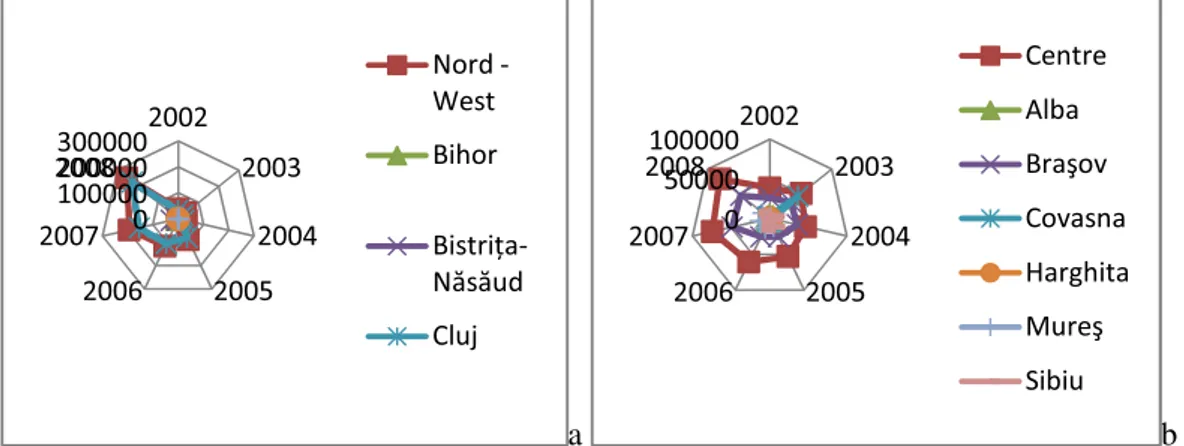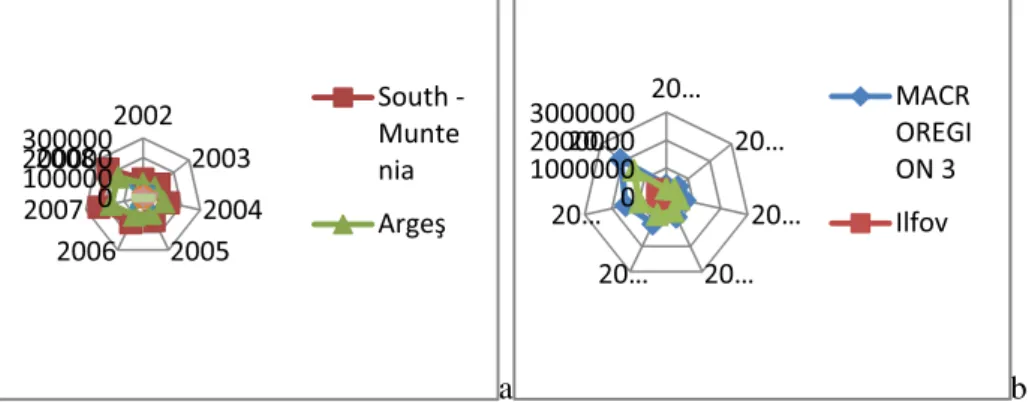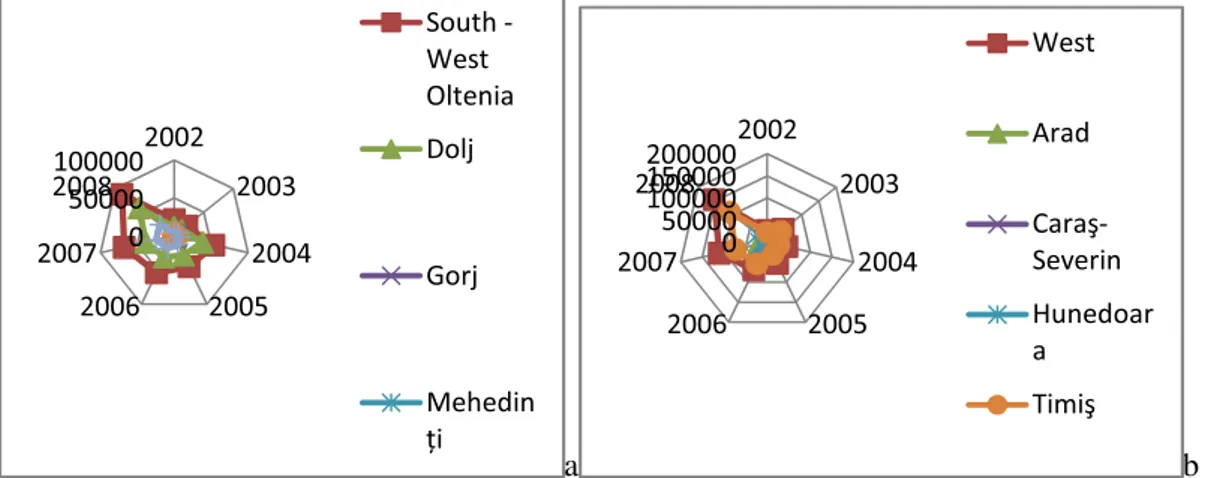A REGIONAL STUDY OF FINANCIAL RESOURCES INVOLVED IN RDI SECTOR IN ROMANIA IN THE LAST DECADE
Nicolov Mirela
University of Oradea, Faculty of Economic Science Aurel Vlaicu University of Arad, Faculty of Engineering
The present paper present a study done on the Financial Resources in Research Development and Innovation (RDI) sector in Romania during 2000-2010 . These studies are conducted on the regions and counties in Romania in the specified period.
The present study is part of Doctoral Grant “Implications for innovation, research and development role in the development of Romania's economic competitiveness”, during 2010 and 2013 and having Director: Prof. Dr. Alina Badulescu in Oradea University, Faculty of Economic Sciences.
Key words: Educational Finance, Higher Education and Research Institutions , Education and Research Institutions, Management of Technological Innovation and R&D , Technological Change: Choices and Consequences; Diffusion Processes; Monetary Systems; Standards; Regimes; Government and the Monetary System; Payment Systems ; Budget; Budget Systems;
JEL code : I22 ,I23 , I2, O18, O32, O33, E42,H61.
1. Introduction
Economists have increasingly paid attention to the role played by knowledge in explaining countries growth differentials and diffusion both across countries and regions (Barrios&Strobl, 2009; Jones, 2004; Klenow& Rodriguez-Clare, 2005). Although knowledge and technological progress are in this regard seen as the main engines of economic growth in the long run.It may inevitably increase rather than decrease regional inequalities, and spread across time and space. As a consequence, economic growth may foster divergence rather than convergence across spatial units, suggesting that convergence may evolve non-linearly. When considering the theoretical literature on growth and convergence, a wide array of arguments which arise to advocating for the long term reduction or for the persistence and self-reinforcing nature of economic inequalities across countries and regions (Galor,1996; Pritchett ,1997; Lucas ,2000). The present paper present a study done on the Financial Resources in Research Development and Innovation (RDI) sector in Romania during 2000-2010. These studies are conducted on the regions and counties in Romania in the specified period.
2. Literature review
In the existing literature was studied the firm’s investments in RDI as a way to develop technological capabilities. Technological capabilities are the ability to develop and exploit technological know-how, which is the application of scientific knowledge for commercial purposes. The firm can develop its technological capabilities using several learning approaches. The previous studies were focus on investments in RDI because of its importance in generating new knowledge, which can help the firm achieve an advantage that is difficult to replicate by competitors (Cazurra&Un, 2007).
Regional economic integration (REI) and RDI investment
There are many different definitions and types of REIs (Cazurra&Un,2007).
to a limited set of countries, tend to be accompanied by the standardization of policies rather than simply the reduction of barriers to trade, and may involve the liberalization of not just trade but also the flow of factors of production.
REIs affect firm behavior. Previous studies have not explored the impact on the firm’s RDI investment. There is a large literature on the impact of REIs on country-level trade and foreign direct investment flows (Eden, 2002). The more limited literature on the impact of REI on firms has traditionally focused on the changes in multinational enterprises (MNEs) (Buckley et al., 2001). Some studies are focused on domestic firms and recommend changing strategy in the face of the new environment (Cazurra&Un,2007). REIs have a competing influence on RDI investments, one through product markets and another through factor markets. The REI results in an expanded client base and newcompetitors. These will induce the firm to invest in external RDI after REI to benefit from the easier access to sources of technology.
REIs can be classified in different types depending on the degree of reduction in the controls over the flow of products and factors among the countries (Cazurra&Un,2007):
(1) preferential tariff agreements (PTA) which consist of the partial reduction of internal tariffs to levels below those charged to trade with third countries;
(2) free-trade areas (FTA), such as the North American Free Trade Area (NAFTA), which consist of a reduction in internal limitations to the movements of products among participating countries; (3) customs unions (CU), such as the Southern African Customs Union (SACU), which demarcate a free-trade area with a common external tariff against products of third countries; (4) common markets (CM), such as the Common Market of the South (MERCOSUR), which are customs unions with the free movement of factors of production among participating countries; and (5) economic unions (EU), such as the European Union, which are common markets also involving the harmonization of economic policies.
Regional inequalities evolve in a non-linear way that can be traced back in the 1950s. The evolution of regional inequalities was then usually linked to national economic development paths and the process of industrialization.
Was done an analysis of income disparities who suggested the existence of a “long swing” in regional income inequalities, where there is first, a rise and then a subsequent fall of income differentials caused by the industrialisation process, accompanying national development and the decline of agriculture.
Several authors have built on this idea in a regional context suggesting the existence of a bell-shaped curve of spatial development where inequalities should first increase as developed areas benefit from external economies, location of decision-makers, political power, and capital and labour mobility (Barrios and Strobl, 2009 ). While a non-linear relationship between regional inequality and national income per capita clearly has important implications for economic theory and policy, there is to the best of our knowledge no explicit econometric study that has set out to investigate its existence, although a number of works have been suggestive of its possibility. In the current paper we explicitly test this hypothesis using data for EU countries. The EU economy arguably makes for a particularly suitable case study given the sizeable disparities in economic development across regions and countries compared to the US. While the studies concerned countries engaged in deep structural changes that goes along with industrialisation, there are reasons to believe that regional inequalities may be significantly affected by other types of structural changes and may concern industrialised countries. The EU, in particular, has faced a number of such changes over the past two decades in the context of the EU integration process and successive enlargements of the EU.
3. Research methodology
The expenses in research and development activities by occupation and sex and for employees working in the fields of RDI activities. Data were taken from the Romanian National Institute of Statistic updated database Tempo online at 15.11.2011. Data used in this study, for this simulation was taken in April 2012. This research is based on the real data of financial resources from RDI sector, as a case study for Romania.
(Sources:
http://www.insse.ro/cms/files/Anuar%20statistic/13/13%20Stiinta,%20tehnologie%20si%20inov are_ro.pdf)
The central objective was to see what was happened in the period indicated (2000-2010) with financial resources in RDI sector for regions and counties in Romania.
4. Descriptive statistics and results
Total expenditure in RDI activities were recorded from 2002 to 2008. Data were taken from Statistical Yearbook of Romania 2009 and 2010. In this material they will be presented on regions and counties respectively.
Making a Study in Romania on regions and counties, financial resources from RDI sector in Romania we can draw the following conclusions:
Macro region 1 is composed of North-West of the 6 counties components: Bihor, Bistrita Nasaud, Cluj, Maramures, Salaj and Satu Mare region and Central region counties of Alba, Brasov, Covasna, Harghita, Mures and Sibiu. Performing a study on a macro draw conclusions: In the North West region RDI expenses represent 50.13% of values recorded in a Macro region 1. The maximum values recorded in RDI expenditures were recorded in Cluj County and was starting in 2002 with a value of 33266.5 RON and the lowest value was registered in 2004 at a minimum value of 22852 RON, then increased by 9.98 times to the value of 228243 RON in 2008 .High levels of RDI expenditures were recorded in the county Bistrita Nasaud with values between 1557.9 RON in 2002 and 27315 RON in 2007and in 2008 to be down to 40% in 2007. The lowest financial resources from RDI sector were recorded in Maramures county which values vary between 145.7 RON in 2003 and 3723 RON registered in 2008.
a b
Figure 1:Expenses in RDI system in Romania: a) the values for the financial resources from RDI registered in Region Nord-West and the counties that belong to this region;b) the values for the expenses from RDI registered in Central Region and the counties that belong to this region. [Source: graphics are from authors results based on the data took from https://statistici.insse.ro/shop/index.jsp?page=tempo2&lang=ro&context=26: ]
In the Central region of a macro region 1 is found that counties like Brasov, Sibiu and Mures, has RDI activity where are registered RDI expenditures.
In Brasov was recorded the largest amounts of total financial resources in RDI activity from which the minimum values was recorded in 2005 and was 25 455 RON. In 2003 the spending
,
;(F 9'#
&3(
&'#&GF ;H'H+
$+I
,
#
$6
J(B
(B'
@.3&#
-+J
values were 33573.7 RON and in 2004 the values are 35466 RON. Maximum values recorded was 48653 RON. In Sibiu expenses with RDI are between values recorded in 2004 as 2607 RON and the maximum value recorded as 16108 RON in 2006. After that the values decline in 2007 to 39.5% of the value recorded in 2006. In Mures county the values of expenditures for RDI was in the range of 1515.6 RON in 2002 and a value of 12639RON registered in 2006. RDI minimum values for financial resources were recorded in
Harghita county, values between 146 RON in 2005 and 1421 RON registered in 2008.
Macro region 2 is composed of the six North Eastern counties: Bacau, Botosani, Neamt, Iasi, Suceava, Vaslui and South East Counties: Braila, Buzau, Constanta, Galati, Tulcea and Vrancea.
In North Eastern region values recorded for expenses in RDI sector represented 52.4% of the values recorded in Macro region 2 in 2002 respectively 68.39% in 2008.Iasi County recorded the highest values for total expenditure from RDI activity between 15116.4 RON values, recorded in 2002 and the value of 176282 RON registered in 2008. In Bacau , the values increased from 4439.1 RON 2002 and 8497 RON in 2006 after spending values have plummeted in 2007 to 5925 RON then increase to values of 7983 RON in 2008. In Suceava
financial resources were in the range of 2258.2 RON in 2002 and 18635 RON in 2008. The lowest values recorded in the North East are registered in Botosani and range were from 383.1RON in 2002 and 2871 RON in 2007. In 2008 the values were down to 2637 RON.
In the South East region were recorded the amounts of expenditure on RDI sector that represent 47.60% of values recorded in 2002 Macro region 231.61% respectively in 2008. In Galati County was the highest value for total expenditure in research -development and innovation (RDI) sector, ranging between 12964.5 RON in 2003 and 25379 RON in 2008.
In Constanta county was register values between 4718.2 RON in 2002 and 25379 RON in 2008. Lowest values recorded in the South East were in Vrancea County and were between 134.5 RON in 2002 and 818 RON in 2007 . After that in 2008 the values from the expenses fell to 461 RON.
a b
Figure 2:Expenses in RDI system in Romania: a) the values for the expenses from RDI registered in Regions Nord-Est and the counties that belong to this region;b) the values for the expenses from RDI registered in Regions Centre and the counties that belong to this region. [Source: graphics are from authors results based on the data took from
https://statistici.insse.ro/shop/index.jsp?page=tempo2&lang=ro&context=26: ]
Macro region 3 is composed of South Region with his 6 counties: Arges, Calarasi, Dambovita, Giurgiu, Ialomita, Prahova and Virginia and Bucharest-Ilfov region with its two components: Ilfov and Bucharest. Expenses in the three macro region were values varies between 393611 RON in 2002 and 2091512 RON registered in 2008.
,
;(F '#
H+
(#(J &
"J&
; G
,
(+#3F '#
H&$
+?H+
('#G
In the South Region, expenses from RDI system vary from 90884.7 RON in 2002 and 231770 RON in 2007. In 2008 the values for the expenses decrease to 229496 RON. The values recorded in the South Wallachia is 23.09% of values recorded in Macro region 3 in 2002 that 10.97% recorded in 2008 . The maximum values of the financial resources of RDI activity is registered in
Arges county and the variation was from 69021.4 RON in 2002 to the maximum value of 167737 RON in 2007. After that, the values decline in 2008 to 163314 RON. It follows that Prahova
counties values vary between 10146.3RON spending in 2002 to 43073 RON in 2007. The corresponding values then decrease to a minimum value in 2008 of 27199 RON. The lowest values recorded was in Ialomita county, with values between 0 and 765 RON registered in 2002 and 2005.
Macro region 3 includes Bucharest-Ilfov region which have the highest values for expenditure on RDI. Thus in the Bucharest – Ilfov region the highest values recorded for RDI activities , the values were in the range of 76.91% in 2002 and 89.03% in 2008 compared to values recorded in Macro region 3. The maximum expenditure of RDI are registered in Bucharest and values range were from 262785 RON in 2002 and 1487299 RON. The registered expenditures in Ilfov county ranged from the values of 39941.3 RON in 2002 and 374717 RON registered in 2008
Macro region 4 is composed of South-West Oltenia Region and have the following counties: Dolj, Gorj, Mehedinti, Olt and Valcea. West Region have the next counties: Arad, Caras-Severin, Hunedoara and Timis. Expenses recorded in Macro region 4 varies between values recorded in 2002 as 48176 RON and 241464 RON registered in 2008.
In the South West Oltenia Region, expenses as financial resources involved in RDI sector were in the range of 21306.5 RON, values which represent 44.83% of values recorded in Macro region 4 and were registered in 2003. The value of 88164 RON registered in 2008, represent 36.51% of values recorded in Macro region 4. The maximum values recorded for the expenditures in the South-West Oltenia were in Dolj county and was 11900.1 RON in 2002. This value vary between 11900.1RON in 2002 and 59395 RON in 2008. The minimum values are recorded in Mehedinti
county and the values are in the range 19 RON in 2008 and 1342 RON 2006. Between the two lies Valcea county whose values are between 43801 RON registered in 2002 and 24849 RON registered in 2007.In 2008 expenses decrease by 640 RON.
a b
Figure 3:Expenses in RDI system in Romania: a) the values for the expenses from RDI registered in Regions South-Muntenia and the counties that belong to this region;b) the values for the expenses from RDI registered in Region Ilfov and Bucharest.
[Source: graphics are from authors results based on the data took from
https://statistici.insse.ro/shop/index.jsp?page=tempo2&lang=ro&context=26: ]
In the Western region RDI costs were 55.17% of values recorded in Macro region 4 and are 26577.6 RON, value registered in 2002.The maximum value of 63.49% of values recorded in Macro region 4 was registered in 2008 and represents 153300 RON. Maximum values for RDI expenditure in the West Region are registered in Timis county with values ranging between
,
(+#3F -+# &
.J
4
4
4
4 4
4 4
-K" K;
22142.1 RON in 2002 and 109603 RON registered in 2008. The minimum values are registered in Arad county. The values for Arad county were registered in 2002 for the value of 593.8 RON and the maximum value recorded was 21083 RON in 2007.
a b
Figure 4:Expenses in RDI system in Romania: a ) the values for the expenses from RDI registered in Regions South West Oltenia and the counties that belong to this region;b) the values for the expenses from RDI registered in Region West and and the counties that belong to this region.
[Source: graphics are from authors results based on the data took from
https://statistici.insse.ro/shop/index.jsp?page=tempo2&lang=ro&context=26: ]
5. References:
1. Barrios S., Strobl E., (2009) The dynamics of regional inequalities, Regional Science and Urban Economics 39, p.575–591
2. Buckley, P.J., Clegg, J., Forsans, N., Reilly, K.T., (2001). Increasing the size of the “country”: regional economic integration and foreign direct investment in a globalisedworld economy,
Management International Review 41, p.251–274.
3. Capron, L., Dussauge, P., Mitchell, W., (1998) Resource redeployment following horizontal acquisitions in Europe and North America 1988–1992, Strategic Management Journal 19, p.631– 661.
4. Cazurra Cuervo- A, Un C. A,(2007), Regional economic integration and R&D Investment,
Research Policy 36 ,p. 227–246.
5. Eden, L., (2002), Regional integration and foreign direct investment: theory and lessons from NAFTA. In: Kotabe, M., Aulakh, P.S. (Eds.), Emerging Issues in International Business Research, Edward Elgar, Northampton, MA, p. 15–36.
6. Eurostat: Regional and Urban Statistics Reference Guide 2009, (http://epp.eurostat.ec.europa.eu/cache/ITY_OFFPUB/KS-RA-09-008/EN/KS-RA-09-008-EN.PDF
7. Galor, O., (1996), Convergence? Inferences from theoretical models, Economic Journal 106 (437), p.1056–1069.
8. https://statistici.insse.ro/shop/index.jsp?page=tempo2&lang=ro&context=26, National Institute for Statistics, updated database at 15.11.2011
9. Jones, C.H.I.,( 2004), Growth and Ideas, NBER Working Paper 10767.
10. Klenow, P.J., Rodriguez-Clare, A., (2005), Externalities and growth, Handbook of economic growth, In: Aghion, Philippe, Durlauf, Steven (Eds.), 1. Handbook of Economic Growth, vol. 1. Elsevier, pp. 817–861. chapter 11.
11. Pritchett, L., (1997), Divergence, big time. J. Economic Perspectives 11 (3), p.3–17. 12. Romanian Statistical Yearbook, cap.13: Science, Technology and Innovation, 2008.
,
(+#3F 9'# K$#&
($I
(I
-3& G&
,
9'#
JF B&
@+(



